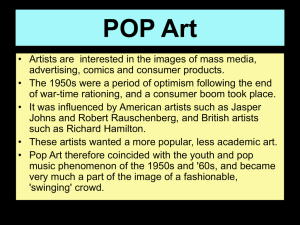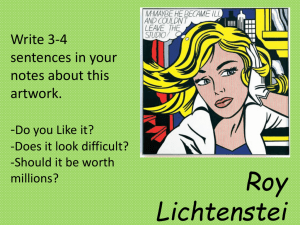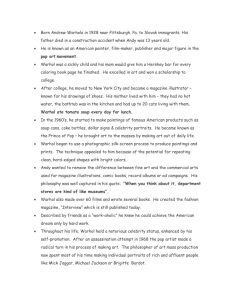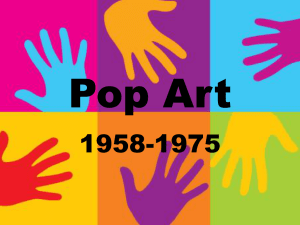Pop Art
advertisement
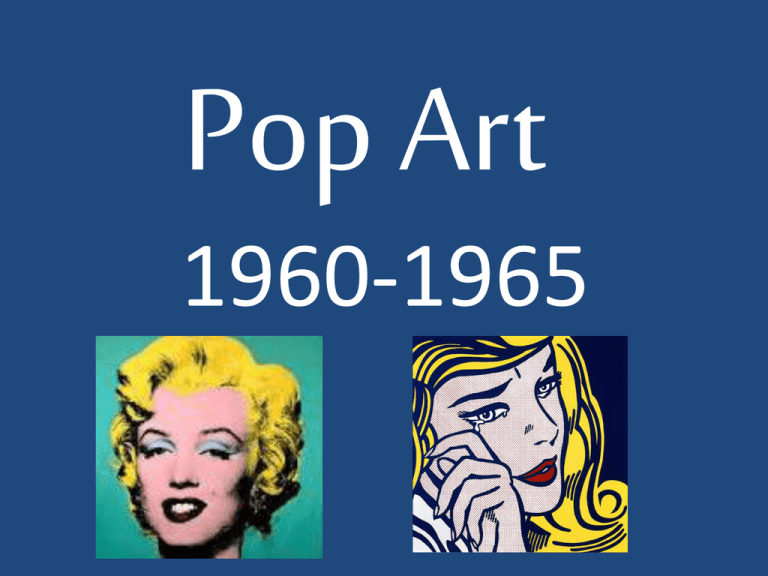
Pop Art 1960-1965 Pop Art Pop Art was first coined in Britain in 1955 but unsurprisingly the Americans took up the consumerist cause with much greater effect and conviction, and became the pioneers of the movement. Pop art and pop culture refers to the products of the mass media evolving in the late 1950s and 60s and also to the works of art that draw upon popular culture - packaging, television, advertisements, comic books, the cinema. In America, Pop Art is often considered as a counter-attack against Abstract Expressionism because it used more figurative aspects in its works. Andy Warhol 1928-1987 American painter, printmaker, and filmmaker • Andy was born in Pennsylvania to Ondrej (aka Andrej) and Julia Warhola Coca-Cola 3 Bottles, 1962 • In 1949, he graduated from Carnegie Institute of Technology and then left for New York City to seek work as a commercial artist • By the mid-1950’s he had a flourishing career as a commercial artist • In 1962, Warhol gave his first one-man show. His art represented images taken unchanged from the commercial environment around him – comic strips, Small Torn Campbell's Soup movies, billboards, fast food, and grocery-store shelves. Can (Pepper Pot), 1962 Warhol created images that became cultural icons, or symbols, of 1960’s capturing public figures such as Jackie Kennedy, Elvis Presley, Marilyn Monroe and Mick Jagger. Turquoise Marilyn , 1962 Jackie Kennedy Liz Taylor Mick Jagger John Wayne, 1986 http://www.webexhibits.org/colorart/marilyns.html Red Elvis, 1962 Warhol used a mechanical silk screen process to give his artwork a mass-produced look. Silk screen is a stencil method of printing a flat-color design through a piece of silk or other fine cloth. The parts that are not to be printed are blocked out with a piece of film. By using this method, Warhol could print the same image in different color combinations. Warhol’s studio was known as “The Factory” because a team of assistants helped him produce his silk screens. In Red Elvis, Warhol has repeated the face of Elvis to resemble a sheet of postage stamps. http://www.youtube.co m/watch?v=UDVHB718ii A&feature=fvwrel In 1976, he did the Skulls, and Hammer and Sickle series. Throughout the late 70s and 80s, a retrospective exhibition was held, as Warhol began work on the Reversals, Retrospectives, and Shadows series. Nine Multicolored Marilyns (Reversal Series), 1976-1986 Andy Warhol, Shadows, 1978-79 The Myths series, Endangered Species series, and Ads series followed through the early and mid 1980s. The Myths Portfolio is one of Andy Warhol's most sought after collections. Warhol's Myths collection contains ten screen prints of iconic mythical figures, including Santa Claus, Mickey Mouse and Superman. Endangered Species series, 1983 African Elephant, 1983 pine barrens tree frog Siberian tiger Grevy's zebra On 22 February 1987, a "day of medical infamy", as quoted by one biographer, Andy Warhol died following complications from gall bladder surgery. He was 58 years old. Roy Lichtenstein 1923-1997 • He was born in New York to Milton and Beatrice Werner Lichtenstein. • Roy studied with Reginald Marsh at the Arts Students League in the summer of 1939. • In 1939 he graduated from Benjamin Franklin High School in New York City. • Roy served in WWII from 1943-46 and his job was to draw maps for troop movements across Germany. • In 1946 he received his Bachelors of Fine Arts degree and in 1949 earned his Masters of Fine Arts from Ohio State University • He taught at Ohio State University (‘46-’51), New York State University (‘57-’60), and Rutgers University in New Jersey (‘60-’63) • In the 1950s, he used various techniques of Abstract Expressionism, did figurative work, and like many of his generation, began employing pop art images. But he was searching for a style. • In 1961 he began to paint in the style that became known as Pop Art. It was at this time that he first made use of devices which were to become signatures in his work Benday dots, lettering and speech balloons. Bratatat!, 1962 • Roy based his paintings on comic strips, it was a style that was fixed in its format: black outlines, bold colors and tones rendered by Benday dots (a method of printing tones in comic books from the 1950's and 60's. First developed by Benjamin Day in 1878). He took impersonal images from all sorts of commercial sources including comic books, newspaper advertisements, and the yellow pages and transformed them into large, hard line works. He was also creating images of all kinds of highly advertised consumer goods during this postwar era, such as a golf ball, a washing machine, a sock. • In 1962, he had a landmark exhibition at the Castelli Gallery that showed enlarged depictions of advertisements and comic strip images. In fact, it was gallery owner Leo Castelli who, as a major promoter of the contemporary art scene, was a key person in launching his career. He was able to stop teaching and work as an artist becoming a major participant in the Pop Art movement. • Roy was inspired by Picasso, Mondrian, and Monet Roy Lichtenstein, Girl with Tear I, 1977 Girl with Tear III, 1977 Three musicians by Fernand Leger Stepping Out, 1978 Inspiration from Piet Mondrian Roy Lichtenstein’s Nonobjective II, 1964 Nonobjective I, 1964 Inspiration from Claude Monet Roy Lichtenstein’s Water Lilies with Cloud, 1992 Water Lilies with Japanese Bridge, 1992 Water Lily Pond with Reflections, 1992 In the 70’s and 80’s “Artist’s Studios” incorporated elements of his previous work. Interior with Waterlilies, 1991 Artist’s Studio No. 1, (Look Mickey)1973 Lichtenstein is best known for his paintings based on comic strips, with their themes of Violence & war Passion, Romance, http://www.cbsnews.com/video/watch/?id=7299118n Science Fiction, Wayne Thiebaud 1920 • Wayne was born in Mesa, Arizona and moved to Long Beach, California when he was only six years old. • In high school, he participated in theatrical productions creating multicolored backdrops as well as special light effects. • He enjoyed cartooning and illustration in high school and at sixteen was hired by Walt Disney Studios in Los Angeles to work in the animation department. • Thiebaud took commerical art courses at a small trade school and eventually became and commercial artist. Thiebaud began working in the commercial arts in the late 1930s, primarily as a cartoonist and designer. • In 1942, he joined the Air Force intending to become a pilot but was soon assigned to the Special Services Dept. as an army artist and cartoonist. • Upon his return to civilian life, he continued working as a commercial artist earning his Bachelor’s degree in 1951 and Master’s in 1952 from Sacramento State College . • After earning his M.A. in 1952, Thiebaud went on to teach at Sacramento City College, eventually landing a position at the University of California, Davis. http://www.youtube.com/watch?v=tACWZe6YolYArtist%20Wayne%20thiebaud%2087 In the 1960s, Thiebaud took a leave of absence from UC Davis to spend some time in New York, where he met abstract expressionist Willem de Kooning and Franz Kline, along with thenemerging artists Robert Rauschenberg and Jasper Johns. • Around the Cake, 1962 • Impressed with their work, Thiebaud began a series of small paintings showing food displayed in windows. Thiebaud’s early paintings incorporated Abstract Expressionism techniques: fast, thick brushstrokes and vivid colors. Boston Cream Pies, 1962 Three Machines, 1963 In the machines, Thiebaud has placed three gumball dispensers in a blank space, outlining them with lines of contrasting color. This technique intensifies the color, creating a vibrating “halo” effect. • From 1957 to 1960, Wayne worked at establishing his own personal style - The objects in his paintings were the focus; he rendered them clearly, reflecting his interest in composition, light, and the application of the pigment. Pies, Pies, Pies, 1961 Cakes, 1963 • In the 70’s, he started painting landscapes and cityscapes that featured dramatic shifts in perspective and multiple points of view. His paintings show complicated freeways, roadways, automobiles, skyscrapers and the ocean. Urban Freeways, 1979 • In 1994, Thiebaud was presented with the National Medal of the Arts and his works are shown in many museums through the world. Hill Street (Day City), 1981 Window Views, 1993
